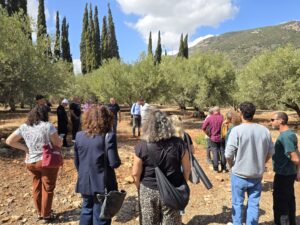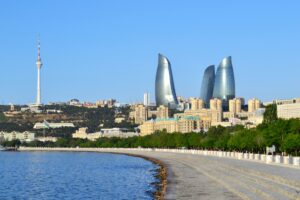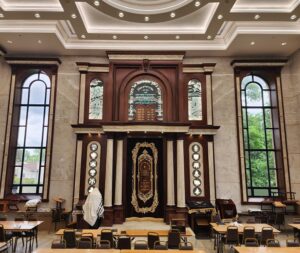Sri Lanka is emerging as a favored destination for Israeli tourists, buoyed by the commencement of a direct flight route by Arkia Airlines. Renowned globally for its pristine white beaches, ideal surfing conditions, and rich tapestry of historical sites, Sri Lanka offers an alluring blend of experiences. Additionally, the island boasts a captivating Jewish heritage, adding another layer of intrigue for Israeli travelers.
When planning a journey to Sri Lanka, it is recommended to delve into its lesser-known Jewish history and cultural facets, often overlooked in conventional tourist literature and by travel agencies.
Local lore intertwines with biblical narratives, as Sri Lanka is believed to have served as a haven akin to the Garden of Eden for Adam and Eve upon their expulsion. This sentiment is echoed in the Sinhalese name for the island, "Sri Lanka," meaning "magnificent island."

According to local folklore, Adam's Peak, nestled in the island's heartland, is so named because it bears the footprint of the first man. It identified as the biblical Mount Ararat, where Noah's Ark found refuge after the Great Flood.
In biblical accounts, Tarshish is mentioned as a destination for King Solomon's merchant ships, bringing treasures like gold, silver, and exotic fauna. Sri Lanka's port city of Galle is believed to be the Tarshish referenced, where Solomon's vessels docked, exchanging commodities including peacocks and apes indigenous to the island. Elephants, emblematic of Sri Lanka, are also thought to have been among the traded goods.

Fortress and the Gulf of Galle, the biblical Tarshish
Historical records trace the presence of Jews in Sri Lanka back to ancient times. The earliest documentation of Jews in Sri Lanka dates back to the period of the Second Temple. An ancient manuscript recounts an account of a Phoenician ship that arrived on the shores of Sri Lanka after a voyage of 72 days, and some of its sailors fell ill and died. It is written that one of the sick sailors was from Jerusalem.
Further evidence of Jewish settlement emerges in the ninth century, with accounts from Persian traveler Abu Sa'id al-Hasan visited Sri Lanka, and in his travelogue, he writes of finding a "large number of Jews" on the island.
During the reign of a Sinhalese king in 1154, Jews held 4 ministerial positions in the government of 16 members, comprising a significant proportion of the ruling council. This underscores the esteemed status and influence of the Jewish community during that period.
Nine centuries ago, Rabbi Benjamin of Tudela ventured into Sri Lanka, chronicling his travels in the esteemed "Book of Travels," wherein he documented a thriving Jewish community of around 3,000 residents. This enclave stood out as one of the largest he encountered during his extensive journeys in the East. Were he would revisit today, Rabbi Benjamin would find a Jewish presence in Sri Lanka primarily drawn by the allure of its surfing scene. While none claim Sri Lanka as their birthplace or permanent abode, a handful of Israelis have chosen to make the island their home.
Throughout the colonial era, spanning from 1500 to 1948, Sri Lanka was subject to the dominion of three successive powers. In the mid-15th century, Portuguese conquest led to the renaming of the island as Ceylon. Alongside the Portuguese, numerous Jewish immigrants arrived, contributing to the maritime industry as shipbuilding managers, accountants, traders, and builders of ports along the northern and western coasts. The expulsion of Jews from Spain in 1492 precipitated a significant influx of Sephardic Jews to Ceylon. However, their arrival was met with persecution as the Portuguese authorities, in tandem with the Inquisition, enforced conversion upon the Jewish population. Despite coercion, some secretly adhered to Jewish customs, earning them the moniker "Marranos." Conversely, the descendants of mixed marriages between Sri Lankans and European Jews or Christians were dubbed "Burgers," a group characterized by fair complexions and elevated socio-economic standing. Presently, Christian Burgers bear Jewish surnames like David, Solomon, etc.
indicative of their Jewish ancestry, though they have severed ties with Judaism.
In 1640, Dutch conquest supplanted Portuguese rule, with Jewish immigrants from Amsterdam and Malabar, India, swelling the island's Jewish population. Notably, in the late 18th century, a Dutch-born Jewish professor, Leo Van Dort, assumed leadership of the Hebrew department at Columbo University in Ceylon, where he accomplished the pioneering translation of the Quran into Hebrew.
The British Empire asserted control over Sri Lanka in 1798, ushering in an era of prosperity for the island's Jewish community. Jews wielded significant influence across various spheres of public life, with prominent figures occupying senior governmental positions. Among the most renowned was Leonard Woolf, Deputy Governor of Hambantota District and spouse of author Virginia Woolf. Woolf's literary masterpiece, "A Village in the Jungle," offers a poignant portrayal of life in Ceylon during his tenure, cementing its status as a literary classic.
Until the mid-20th century, the bustling capital of Colombo boasted the iconic "Great Synagogue," serving as a spiritual hub for both British soldiers, government officials, and local residents alike. Its grandeur implied the existence of smaller synagogues, at least one more within the vicinity. A glimpse of the Great Synagogue's former glory is captured in a poignant 1966 photograph by Zeev Raphael.

On the synagogue's erstwhile location now stands the Cinnamon Red Hotel. Once, its lobby proudly displayed a sign bearing the simple yet profound inscription, "The Synagogue," a relic of bygone days that vanished amidst the hotel's renovations years ago.

With the conclusion of the British mandate in 1948, three months preceding the establishment of the State of Israel, the synagogues fell silent as Sri Lanka's Jewish community dispersed, many opting to immigrate "Aliya" to Israel or settle in England. Left to languish in neglect, the Great Synagogue eventually succumbed to ruin, making way for the construction of the Cinnamon Red Hotel. Across the street, the edifice now known as the Chabad House emerged, a beacon of Jewish continuity in Colombo.
While Sri Lanka's Jewish community lacked formal educational institutions or revered Rabbis scholars, it boasted remarkable individuals whose legacies endure. Notably, Anne Ranasinghe, born as Hannah Katz, emerged as the nation's esteemed poet laureate. When the Nazis came to power, her parents sent her to London to study at a nursing school. Her parents were murdered in the Holocaust. While working as a nurse in a London hospital, she met a young doctor who came from Sri Lanka to specialize in England. They fell in love, got married, and she returned with him to his homeland in Sri Lanka, where they had seven children.
In her twilight years, Anne Ranasinghe found solace in her ancestral faith, even coming to the Chabad House in Colombo. When she was interviewed in the press, she used to declare "I am the last Jew in Sri Lanka." reverberating with poignancy, underscoring her profound connection to Judaism. Upon her passing in 2016, she left a poignant request in her will to be laid to rest as a Jewish. Today, her former residence on 82 Roamid St. stands silent, devoid of the recognition befitting a national poet, its significance obscured by the passage of time.

In the same vibrant neighborhood, a towering testament to cultural harmony stands a Buddhist girls' school of paramount importance, bearing the indelible imprint of Marie Musaeus Higgins. Marie's journey traversed continents and cultures, culminating in her transformative impact on Sri Lanka's educational landscape. Her father was the head of the Jewish community in Königsberg. Marie embarked on a transatlantic odyssey, finding love and loss in America before settling in Sri Lanka. As a devoted educator and prolific author, she penned captivating English children's books on Buddhism, elevating her to prominence as a revered Western Buddhist teacher.

Driven by a fervent belief in gender equality, Marie established the school to provide girls with the same educational opportunities afforded to their male counterparts. Her legacy endures in the school that bears her name, a beacon of academic excellence and empowerment. Notably, the school's entrance bears a swastika, a symbol imbued with ancient significance in Buddhist culture, predating its appropriation by the Nazis. The current principal asserts that the emblem's use predates Hitler's era, serving as a testament to the school's rich heritage rather than any association with Nazi ideology.

In a previous era, another luminary graced the shores of Sri Lanka, a scion of Berlin's rabbinical lineage, Sigmund Feninger. Fleeing the specter of Nazi persecution, Sigmund sought refuge in Sri Lanka, then under British rule. Amidst the turmoil of World War II, he found sanctuary in the lush confines of the Ouduwakale Forest, nestled in the verdant mountains overlooking Kandy. Embracing the teachings of Buddhism, he embarked on a spiritual quest within the confines of a secluded monastery, ultimately renouncing his former identity to emerge as Nyanaponika Mahathera.
Nyanaponika's erudition and dedication bore fruit as he translated sacred Buddhist texts into German and English, catalyzing the dissemination of Buddhist teachings in the West. His disciples, recognizing the profundity of his wisdom, established the BPS publishing house to immortalize his works, which garnered global acclaim. Thus, Nyanaponika Mahathera stands as an emblematic figure in the bridge between Eastern spirituality and Western consciousness, his legacy reverberating through the annals of Buddhist scholarship.

Feninger with the secretary of Ben Gurion, Itzhak Navon, in Burma 1961
Nonetheless, Sigmund Feninger remained steadfast in his Judaism. In 1961, during a visit by Israeli Prime Minister David Ben-Gurion to neighboring Burma, Feninger seized the opportunity to engage in a profound dialogue with Ben-Gurion. Their conversation, spanning many hours, laid the foundation for a lasting correspondence that endured until Ben-Gurion's passing. Feninger himself passed away in 1994. Rabbi Yitzhak Carmeli, a friend of mine, managed to reach the monastery where Feninger had resided. There, he bore witness to Feninger's modest abode, observing his room and bed. Beneath the bed lay a wooden box containing Feninger's personal effects, which the monk graciously permitted Carmeli to inspect. Among the documents, Carmeli recounted, were childhood photographs of Feninger in Berlin, adorned with a traditional kippah and peyot, alongside familial snapshots featuring elderly relatives donning hats or caps.
The axiom that a Jewish cemetery serves as a repository of a community's history holds true even in Sri Lanka. Within the confines of the Borella cemetery in central Colombo, stand tombstones that offer insights into the Jewish presence in the city. One such marker commemorates the life of a 7-year-old girl, her white marble pillar etched with Hebrew script, a silent testament to a bygone era.

Nearby lies the resting place of Abraham, son of Rabbi Gershom, his epitaph bearing witness to his passing in 1898 and his father's rabbinical role in Colombo.

While the cemetery bears witness to the lives of many Jews, the absence of Jewish symbols or Hebrew inscriptions on some graves reflects a prevailing desire among Sri Lanka's Jewish community to conceal their faith, even in death. Elderly Jewish women, wary of potential desecration, opted for anonymity in burial, eschewing the ostentatious displays often associated with funeral rites. Nevertheless, amid the rows of tombstones, two stand adorned with the Star of David, marking the final resting place of British soldiers, including two Jews, who fell victim to Japanese bombings during World War II.

The annals of Sri Lanka's history are replete with notable Jewish figures who left an indelible mark on the island's cultural, judicial, and economic landscape. Among them, Sir Sidney Abrahams and Sir Alan Rose served with distinction as Chief Justices of Ceylon, while William Cohen emerged as a titan in the realm of banking, founding the esteemed Mercantile Bank of Ceylon. Noteworthy, too, is the architectural legacy of Daniel Ulrik Plesner, a Danish Jew whose visionary designs grace numerous landmarks across Ceylon. Plesner's journey culminated in his relocation to Israel, where he passed away in 2016 during a visit to his homeland in Denmark, leaving behind a legacy that transcends borders and generations.
Among the ranks of influential Jews in Ceylon, Heidi Solomon Koenig stands out a beacon of compassion and resilience. As the wife of the Minister of Defense, she earned enduring praise for her pivotal role in averting mass starvation during wartime, a feat that reverberates through history. Hailing from a devout Jewish family in Austria, Heidi's legacy serves as a testament to the indomitable spirit of humanity in the face of adversity.
Similarly, the saga of Ruth Miller and her husband, Joe de Silva, epitomizes the cross-cultural tapestry of Ceylon's history. Following World War II, Ruth embarked on a transformative journey to Europe, where she crossed paths with Joe, her future spouse. Together, they returned to his homeland in Ceylon, where Ruth carved a niche for herself as a journalist at the esteemed Ceylon Daily News. However, her outspoken communist leanings led to her deportation, alongside her close friend Claudine Liebovitch, sparking a global media campaign for their repatriation.

The economic landscape of Ceylon, dominated by the tea industry since the 19th century, owes a debt of gratitude to the visionary de Worms brothers, Morris, Gabriel, and Solomon, who hailed from the illustrious Rothschild family. Initially drawn to the fertile lands of Ceylon for coffee cultivation, their fortunes pivoted when a blight ravaged their crops. Undeterred, they transitioned to tea cultivation, capitalizing on Ceylon's optimal climate and fertile soil. Their high-quality tea soon garnered acclaim across Europe, cementing Ceylon's reputation as a leading tea exporter. The citizens of Ceylon acknowledge the pivotal role of the Jewish community in shaping their nation's economy.

Gabriel de Worms, in addition to his entrepreneurial prowess, left an indelible mark on Ceylon's political landscape. Elected to the Ceylonese Parliament, he made history by insisting on taking his oath on the Old Testament, a symbolic gesture of faith and identity.
These luminaries represent just a fraction of the rich tapestry of Jewish history in Ceylon. Today, Judaism experiences a revival through the establishment of four Chabad houses across the island. The largest, nestled in Weligama Beach in the south, serves as a vibrant hub of Jewish life, hosting scores of Israeli visitors, particularly surfers drawn to the region's famed waves. At the last Shabbat prayers and Shabbat meal, about 200 Israelis were hosted at the Chabad house.

As Passover approaches, anticipation builds for the gathering of 500 Israelis, underscoring the enduring bond between the Jewish community and the island of Ceylon.
The new Chabad House in Weligama opened shortly before the last Rosh Hashanah, replacing its modest predecessor which struggled to accommodate the growing number of seekers. Nestled on the first floor is the sole kosher restaurant in Sri Lanka, a bustling hub where the arrival of each tuk-tuk or rented scooter signals the entrance of an Israeli. Upon arrival, visitors are greeted by the sight of the tefillin stand, where they pause to don a kippah and wrap themselves in tefillin. Reciting the sacred "Shema Yisrael" and "Shemoneh Esre," they immerse themselves in prayer before ordering lunch.

Chabad emissary Racheli Romach, alongside her husband Rabbi Yossi Romach, extends a warm embrace to guests, including those who have strayed from their religious roots. "Here, they find a sense of belonging," Racheli reflects, "We welcome all, without exception. Many come burdened by preconceptions, yet here they encounter Shabbat in a light different from their upbringing, a Judaism steeped in love rather than fear, a place where faith is nurtured and repentance embraced."

Chabad emissary Yossi and Racheli Romach
The Chabad House is not merely a culinary haven; it also serves as a spiritual oasis, offering Torah classes and engaging events throughout the week. From the enlightening Tanya class every Sunday evening to the experiential "Traveling by the Fire" gathering every Tuesday, guests are invited to immerse themselves in Hassidic stories and weekly Torah insights. A poignant highlight is the weekly Hafrashat Chala ceremony, where religious, secular, and former religious women gather, often leading to emotional revelations.

On the second floor of the Chabad House is the synagogue, adorned with the Holy Ark, Torah reading table, and surfboards lining the walls, a unique juxtaposition of tradition and modernity. While Minyan prayers are reserved for Shabbat, occasional weekday Mincha and Maariv services cater when there are enough guests.
This is the only synagogue in the world where I've seen surfboards leaning against the wall in the prayer hall. A local friend says it reminds him 'Fiddler on the Surf'.

A notable custom observed here is the Torah aliyah vows (Nedarim), where the oleh pledges to fulfill a "good resolution" printed on a page placed on the bimah. An inspiring testament to personal growth, like "to learn a saying in the study of redemption and Messiah" or "to observe one Shabbat," and the oleh is asked to choose one.

The third floor is the living quarters of the emissary family, a sanctuary amidst their tireless endeavors.
Four months ago, another beacon of Jewish life emerged in the central Sri Lankan mountains with the inauguration of a Chabad House in Ella. Led by Rabbi Roni Arad, this sanctuary amidst the verdant jungle offers respite to weary Jewish travelers seeking spiritual nourishment amidst nature's embrace. The town of Ella is crossed by the main Wellawaya Rd from which trails branch off. Chill Café is a meeting place for tourists because of its Western food. Next to it, a small path about three meters wide leads into the forest.

After about five minutes of walking, the last house on the trail is the Chabad House. Along the trail, small directional signs are hung. But the direction is found by sound. From among the trees of the forest, Hasidic music bursts from the Chabad House's speaker. Suddenly, a giant yellow Chabad flag hangs on a fence, and only when approaching it we can see the Chabad House.

Nestled within the serene confines of a charming villa, the Chabad House offers a welcoming haven for Israelis and Jews seeking respite amidst their travels. Here, amidst the aroma of freshly brewed coffee and tea, guests engage in friendly conversations or delve into the depths of Torah study with the emissary. Some visitors take advantage of the Chabad House's amenities, including the use of the washing machine, a small but invaluable convenience. The living room serves as a sanctuary of learning, adorned with a vast Hassidic library, though notably absent are the revered of the Holy Ark and Torah scroll.


My visit coincided with a momentous occasion, the eagerly anticipated the first Minyan on a Friday evening, coinciding with Parshat Tetzaveh. The palpable excitement radiating from the emissaries, their children, and their devoted workers underscored the significance of this milestone.
Beyond Weligama, other Chabad Houses dot the Sri Lankan landscape, including those in the idyllic resort town of Arugam Bay, a magnet for Israeli surfers during the summer months, and the capital city of Colombo. While the latter remains closed, it holds the distinction of being the oldest Chabad House in Sri Lanka, strategically situated opposite the Cinnamon Red Hotel, a poignant reminder of the rich Jewish heritage that once graced the city center.

This is one of the oldest Chabad houses in East Asia. The emissary is proud that they even managed to print an edition of the Tanya there.

Remarkably, the laymen of Sri Lanka express a deep affinity for Israel, viewing the nation with admiration and respect. Their admiration stems, in part, from Israel's resilience in the face of Islamic terror, a parallel to their own struggles against the Tamil Tigers. Faced with their government's perceived capitulation to terror, the Sri Lankan populace finds solace in Israel's steadfastness, drawing inspiration from our shared resolve against adversity.
The author was a guest of Arkia and Andrew










